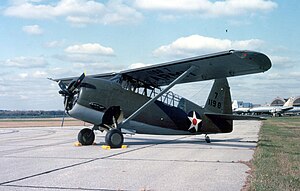| O-52 | |
|---|---|
| The O-52 at National Museum of the United States Air Force | |
| Role | Reconnaissance |
| Manufacturer | Curtiss-Wright |
| Introduction | 1940 |
| Primary user | United States Army Air Corps |
| Produced | 203 |
| Unit cost |
US$31,000
|
The Curtiss O-52 "Owl" is an observation aircraft used by the United States Army Air Corps before and during World War II.
Design and development[]
Developed in 1939, the Curtiss O-52 was the last "heavy" observation aircraft developed for the US Army Air Corps. The concept of the two-seat observation aircraft, classed as the "O" series aircraft, dated to World War I, and in 1940, the Army Air Corps ordered 203 Curtiss O-52s for observation duties. By 1941, the O-52 was no match for modern combat conditions.
Operational history[]
Upon delivery, the aircraft was used in military maneuvers with the USAAC, but following America's entry into World War II, the USAAF determined that the aircraft did not possess sufficient performance for "modern" combat operations in oversea areas. As a result, the O-52 was relegated to courier duties within the U.S. and short-range submarine patrol over the Gulf of Mexico and Atlantic and Pacific Oceans.
The O-52 was the last "O" type aircraft procured in quantity for the Air Corps. Following the attack on Pearl Harbor, the "O" designation was discontinued and the "L" series for liaison-type aircraft was adopted instead.
In November 1942, the USSR ordered 30 O-52 Owls through the Lend-Lease program. Twenty-six were shipped, with only 19 were delivered as a number were lost on the North Arctic Route.[1] Of these only 10 were accepted into service. They were used operationally for artillery fire spotting and general photographic and observation platforms in north and central areas on the Russian Front during spring–summer 1943. One O-52 was shot down by Luftwaffe fighters. The aircraft was generally disliked in Soviet use although some were still flying into the 1950s.
Operators[]
Survivors[]
- A surviving O-52 (s/n 40-2763) is on display in the Early Years Gallery at the National Museum of the United States Air Force at Wright-Patterson AFB near Dayton, Ohio. The aircraft was obtained from the U.S. Federal Reformatory at Chillicothe, Ohio in November 1962.[2]
- O-52 (s/n 40-2746) is at Pima Air & Space Museum in Tucson, Arizona, and is "currently undergoing a detail restoration".[3]
- O-52 (s/n 40-2769) is at Yanks Air Museum in Chino, California.[4]
Specifications (O-52)[]

An O-52
Data from American Warplanes of World War II[5]
General characteristics
- Length: 26 ft 4 in (8.03 m)
- Wingspan: 40 ft 9 in (12.43 m)
- Height: 9 ft 3 in (2.83 m)
- Wing area: 210.4 ft² (19.55 m²)
- Empty weight: 4,213 lb (1,919 kg)
- Loaded weight: 5,364 lb (2,433 kg)
- Powerplant: 1 × Pratt & Whitney R-1340-51 radial engine, 600 hp (447 kW)
Performance
- Maximum speed: 220 mph (191 knots, 354 km/h)
- Cruise speed: 192 mph (167 knots,309 km/h)
- Range: 700 miles (609 nmi, 1,127 km)
- Service ceiling: 21,000 ft (6,400 m)
Armament
- Guns: 1 × forward and 1 × rearward firing .30-cal (7.62 mm) machine gun
See also[]
References[]
- Notes
- ↑ Hardesty 1991, p. 253, Appendixes.
- ↑ United States Air Force Museum 1975, p. 28.
- ↑ "Curtiss O-52 Owl." Pima Air Museum. Retrieved: 18 January 2011.
- ↑ "Curtiss O-52A-1-CW "Owl." Yanks Air Museum. Retrieved: 18 January 2011.
- ↑ Donald 1995, p. 64.
- Bibliography
- Donald, David. American Warplanes of World War II. London: Aerospace Publishing, 1995. ISBN 1-874023-72-7.
- Hardesty, Von. Red Phoenix: The Rise of Soviet Air Power 1941-1945. Washington, D.C.: Smithsonian Institution, 1991. ISBN 0-87474-510-1.
- United States Air Force Museum Guidebook. Wright-Patterson AFB, Ohio: Air Force Museum Foundation, 1975.
External links[]
| Wikimedia Commons has media related to Category:Curtiss O-52 Owl. |
| ||||||||
The original article can be found at Curtiss O-52 Owl and the edit history here.
